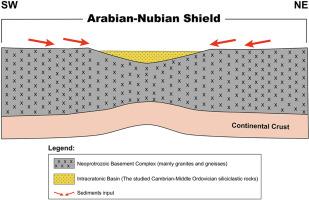Provenance, tectonic setting, paleo-weathering and paleoclimate of the Cambrian–Middle Ordovician sandstones from the Tayma region, Tabuk Basin, NW Saudi Arabia (North Gondwana): Petrographic and geochemical evidence
IF 2.2
4区 地球科学
Q2 GEOSCIENCES, MULTIDISCIPLINARY
引用次数: 0
Abstract
In the Tayma region of northwest Saudi Arabia, the Cambro-Ordovician rock units are gaining growing attention for hydrocarbon and groundwater exploration. Nevertheless, their petrographic and geochemical characteristics have not yet been examined. Accordingly, this study aims to reconstruct the provenance of Cambrian-Middle Ordovician sandstones in the Tayma region, northwestern Saudi Arabia, along with the tectonic setting, paleo-weathering, and paleoclimatic conditions of the source area. This is achieved by the integration of both petrographic and geochemical data (major, trace, and rare-earth elements) of the studied sandstones. The sandstones are collected from the stratigraphic successions comprising the Saq Formation (the Risha and Sajir members, in particular) and the middle member of the Qassim Formation (the Kahfah member). Petrographic analysis reveals that the sandstones consist predominantly of quartz arenite, with subordinate sub-arkose arenite and micaceous quartz wacke. The integration of both petrographic and geochemical data indicates that detritus of the studied sandstones was primarily sourced from Neoproterozoic felsic igneous rocks (mainly granites) with a minor contribution from metamorphic source (mainly gneiss). These source rocks were developed in the interior of a craton, situated within a broad passive continental margin, and were intensely weathered due to prevailing warm and humid conditions. Deposition occurred in intra-cratonic basins after the Arabian-Nubian Shield (craton) stabilized following the Neoproterozoic Pan-African Orogeny, which culminated in the assembly of Gondwana. In terms of a regional perspective, findings of this study support earlier research suggesting that, during the Cambro-Ordovician period, North Africa and Arabia formed a broad, tectonically stable continental shelf along the northern margin of the Gondwana supercontinent, adjacent to the Proto-Tethys Ocean.

沙特塔布克盆地泰马地区寒武系—中奥陶统砂岩物源、构造环境、古风化与古气候:岩石学和地球化学证据
在沙特阿拉伯西北部的Tayma地区,寒武-奥陶系的油气和地下水勘探日益受到关注。然而,它们的岩石学和地球化学特征尚未得到研究。因此,本研究旨在重建沙特阿拉伯西北部泰马地区寒武系—中奥陶统砂岩的物源,以及源区的构造背景、古风化和古气候条件。这是通过整合研究砂岩的岩石学和地球化学数据(主要、痕量和稀土元素)来实现的。砂岩收集自地层序列,包括Saq组(特别是Risha和Sajir组)和Qassim组中段(Kahfah组)。岩石学分析表明,砂岩以石英砂岩为主,次为亚长石砂岩和云母石英屑。岩石学和地球化学资料综合表明,研究的砂岩碎屑主要来自新元古代长英质火成岩(以花岗岩为主),变质岩(以片麻岩为主)贡献较小。这些烃源岩发育在克拉通的内部,位于一个广阔的被动大陆边缘,由于普遍的温暖和潮湿的环境,这些烃源岩受到强烈的风化。在新元古代泛非造山运动后,阿拉伯-努比亚盾(克拉通)稳定下来,最终形成冈瓦纳组合,沉积发生在克拉通内盆地。从区域角度来看,本研究的发现支持了先前的研究结果,即在寒武纪-奥陶纪时期,北非和阿拉伯沿着冈瓦纳超大陆北缘形成了一个广阔的、构造稳定的大陆架,毗邻原特提斯洋。
本文章由计算机程序翻译,如有差异,请以英文原文为准。
求助全文
约1分钟内获得全文
求助全文
来源期刊

Journal of African Earth Sciences
地学-地球科学综合
CiteScore
4.70
自引率
4.30%
发文量
240
审稿时长
12 months
期刊介绍:
The Journal of African Earth Sciences sees itself as the prime geological journal for all aspects of the Earth Sciences about the African plate. Papers dealing with peripheral areas are welcome if they demonstrate a tight link with Africa.
The Journal publishes high quality, peer-reviewed scientific papers. It is devoted primarily to research papers but short communications relating to new developments of broad interest, reviews and book reviews will also be considered. Papers must have international appeal and should present work of more regional than local significance and dealing with well identified and justified scientific questions. Specialised technical papers, analytical or exploration reports must be avoided. Papers on applied geology should preferably be linked to such core disciplines and must be addressed to a more general geoscientific audience.
 求助内容:
求助内容: 应助结果提醒方式:
应助结果提醒方式:


